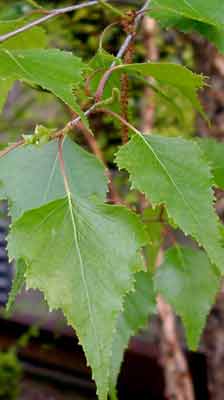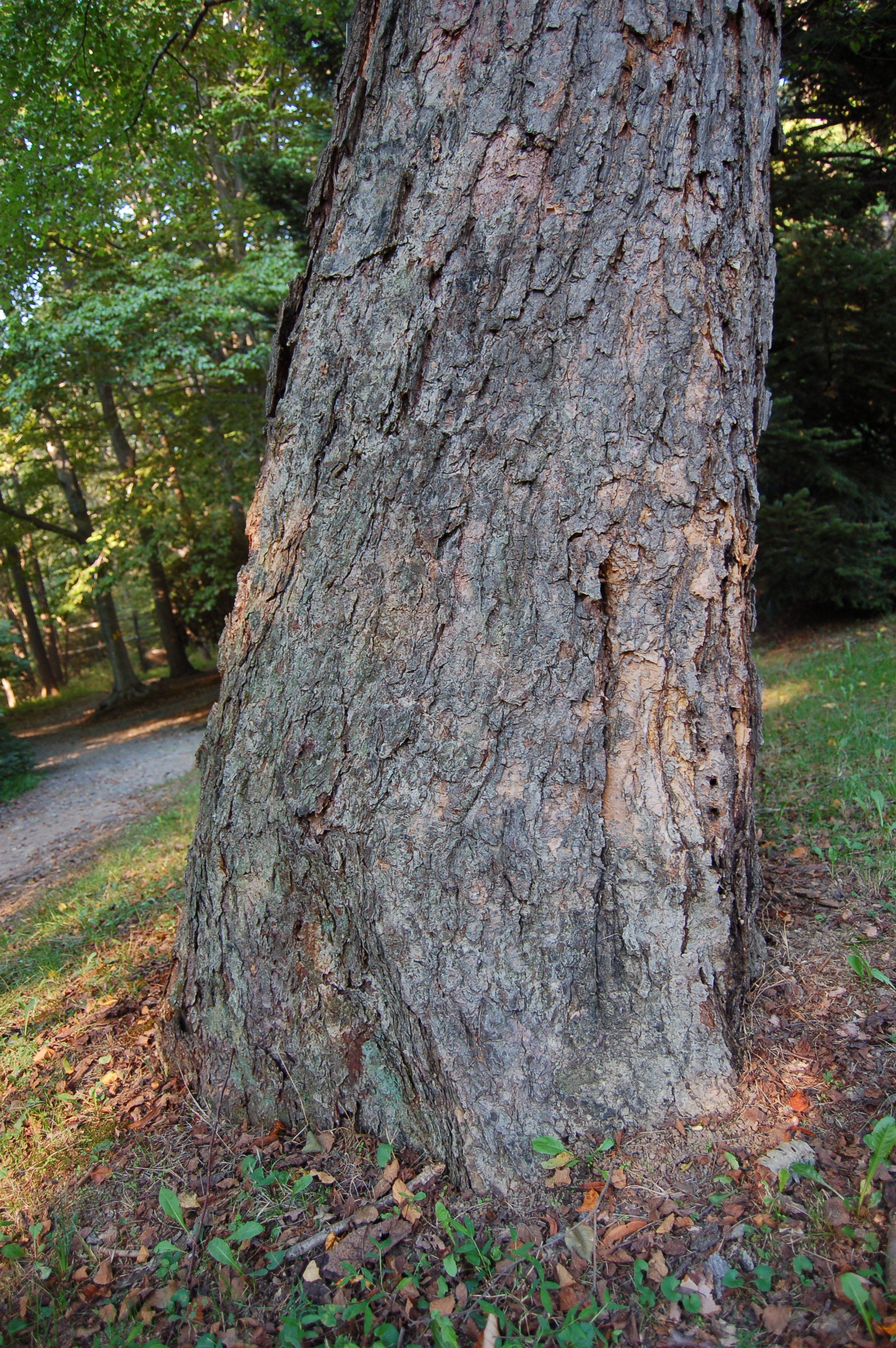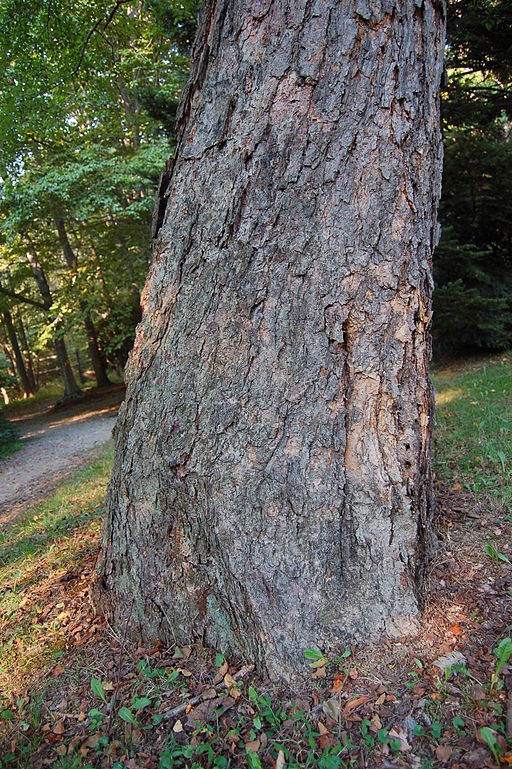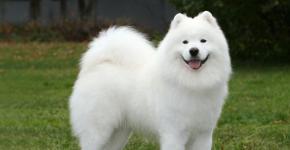River or black birch. Black birch
Black birch (lat. Betula nigra) - a representative of the Birch family of the Birch family. Another name is river birch. The homeland of the species in question is the United States of America. In nature, found on wetlands, flood plains, river valleys and other places with damp sandy soils. It grows in union with the poplars, willows and maples. Fast-growing, thermophilic short-lived view.
Characteristic culture
Black birch - deciduous tree up to 30 m high with an egg-shaped openwork crown. The bark is pink-brown, gray-brown or black-brown, thick-scaly, flaking layers or curls. Young shoots are silvery gray, smooth. The lateral branches are arcuate-deflected, the main ones are located at an acute angle. The leaves are dark green, alternate, short-petiolate, oval or ovate-rhombic, widely wedge-shaped at the base, blunt or sharp, jagged along the edge, up to 12 cm long. On the inner side, grayish or grayish-white, pubescent along the veins. In autumn, the foliage becomes dark yellow.The inflorescences are oblong-cylindrical earrings, equipped with a stem, the length of which varies from 2.5 to 5 cm. Bracts pubescent, scaly, with equal lobes of linearly oblong shape. The fruit is a broadly ovate, winged nutlet, pubescent in the upper part. At present, several cultivated varieties with a shade of wood and resistance to pests have been developed. They are often used for landscaping personal plots.
Growing conditions
In nature, black birch grows on cool, moist substrates. Plants have a negative attitude even to short-term drought. On dry soils, trees develop slowly, often affected by pests. Despite the fact that the culture is thermophilic, it denies the scorching sun, it is better to place the plants in the semi-shaded areas where the sunlight is present for most of the day. Landing of culture from the north or east side of architectural structures is not forbidden. Since black birch reaches a rather impressive size, it is necessary to take into account the location of the electric wires, otherwise during strong winds it is impossible to avoid their breakage.Soils for black birch should not be compacted, as the surface root system on them feels defective. Optimal for the culture of slightly acidic, loose, moist, humus-rich soil. Not welcome heavy clay, strongly acidic or alkaline soils. The fact that black birch is a moisture-loving crop was mentioned more than once, this factor is considered one of the most important conditions for the successful cultivation of plants. But compared to other representatives of the genus, black birch is more drought tolerant, but only short-lived. Without prejudice to the health of the trees will make a light flooding melt waters.
Seed propagation
Black birch, like all other species, propagates by seed. In addition, it gives abundant self-seeding, so the plants are able to capture new territories on their own. In the first few weeks, shoots develop very slowly. They are vulnerable to lack of sunlight, watering and shading by weeds. The plot for sowing should be prepared carefully, removing all rhizomes of unwanted vegetation.Seeds in preliminary preparation do not need, if it is a question of autumn sowing. When sowing birch seeds in black spring, stratification is necessary; it will allow increasing the germination rate. This procedure lasts about 5-6 weeks at a temperature of 0 - + 5С. Before sowing the seeds are dried to a friable state, and immediately sown. Store wet seeds in room conditions can not be, they will begin to germinate and as a result will die.
Sowing can be carried out as in open ground under the shelter, and in the hothouse. Sow seeds in the lowercase way, the distance between the lines should be at least 15-20 cm. Deep embedding is prohibited. For a week, crops are covered with plastic wrap or any other covering material. The soil is kept wet, a spray gun is used for irrigation, a regular watering can can erode crops.
Under all conditions, shoots appear in 2-2.5 weeks. By autumn, seedlings reach a height of 30-50 cm. For winter, young plants are warmed with a thick layer of fallen leaves. The following spring, the plants dive into schools. In schools, the distance between plants should be about 5-7 cm, between rows - 30-35 cm. At the end of summer or early autumn, the grown seedlings are transplanted to a permanent place, underdeveloped specimens are left for growing.
Widespread birch growing in the flood plains and marshes of the United States from New Hampshire to southern Minnesota in the west and to northern Florida and eastern Texas in the south.Leaves and bark.
One of the most thermophilic species of birch. It grows quickly, especially in youth, but is short-lived. Light-requiring
Prefers moist sandy soils, has low fertility. It grows in river valleys, on wet, alluvial soils and marshes, usually in a mixture with the sycamore tree (Platanus occidentalis), elmas (Ulmus), maples (Acer), willows (Salix) and poplars (Populus)
Botanical description
Deciduous tree of small size, height 25-30 m and trunk diameter up to 1.5 m. Crohn openwork, ovate. The bark is of a different color, usually from dark gray-brown to pink-brown, thick-scaly, less often smooth, creamy-pink, exfoliated in the form of paper-like layers; on the young branches of silver-gray.
The leaf position is next. The leaves are ovate-rhombic or oval, 5–12 cm long, 4–9 cm wide, broadly wedge-shaped at the base, acute or blunt at the apex, marginally double-lobed-toothed, dark green above, whitish or grayish from below, on pubescent petioles 6-16 mm long. In autumn, the leaves turn dark yellow.
Pestic earrings are standing, oblong-cylindrical, 2.5-3.5 cm long, on a stem 2.5-5 mm long. Bracts pubescent, 6–7 mm long, with upwardly directed linearly oblong, almost equal lobes.
Nuts broadly ovate, about 3 mm long and wide, pubescent in the upper half. The wings are equal in width to half a nut or a little more. 1000 seeds weight 1.2 g; in 1 kg 850 thousand seeds.
Seeds, unlike other birches, ripen in late spring.
Meaning and application
Since the natural environment of the tree is wet soil - it grows on a high bank, and its bark differs significantly from other types of birch trees, this allows it to be used as a landscape tree. A number of cultivated varieties with more white bark than wild species are selected for landscaping gardens.
Such varieties as ‘Heritage’ and ‘Dura Heat’ are known for being resistant to birch bark with white bark Agrilus anxius in the warm south-eastern regions of the United States.
‘Heritage’ is a tree with a wide pyramidal crown, more powerful than the wild form. Branches and trunk with highly flaking bark, the layers of which are painted in cream, orange, lilac and gray tones (light tones prevail).
‘Heritage’ (‘Little King’) is a compact shrub up to 3.5 m tall with a dense oval crown. Bark cream, orange, white. Autumn leaves are copper. Removes overmoistening, but grows better in normal conditions.
Indians made sweets by evaporating the sap of this birch, similarly to maple syrup, and its inner crust as food in conditions of survival. It is too crooked and knotty to matter as a timber tree.
The wood is heavy, strong, brown.
In the USA it is bred mainly in areas where it is found wildly and only slightly to the north; used for street plantings and landings on the edges of reservoirs. In England, introduced in 1736 in the USSR in culture is not widely spread.
Images
on Wikimedia Commons
| IPNI | |
| Tpl |
Black birch, or river (lat. Bétula nígra) - species of plants of the genus Birch ( Betula) Birch families ( Betulaceae).
Distribution and ecology
Widespread birch growing in the flood plains and marshes of the United States from New Hampshire to southern Minnesota in the west and to northern Florida and eastern Texas in the south.
 |
 |
Leaves and bark. |
One of the most thermophilic species of birch. It grows quickly, especially in youth, but is short-lived. Light-requiring
Prefers moist sandy soils, has low fertility. It grows along river valleys, on damp, alluvial soils and marshes, usually in a mixture with the western sycamore ( Platanus occidentalis), ilmas ( Ulmus), maples ( Acer), willows ( Salix) and poplars ( Populus).
Botanical description
Deciduous tree of small size, height 25-30 m and trunk diameter up to 1.5 m. Crohn openwork, ovate. The bark is of a different color, usually from dark gray-brown to pink-brown, thick-scaly, less often smooth, creamy-pink, exfoliated in the form of paper-like layers; on the young branches of silver-gray.
The leaf position is next. The leaves are ovate-rhombic or oval, 5–12 cm long, 4–9 cm wide, broadly wedge-shaped at the base, acute or blunt at the apex, marginally double-lobed-toothed, dark green above, whitish or grayish from below, on pubescent petioles 6-16 mm long. In autumn, the leaves turn dark yellow.
Pestic earrings are standing, oblong-cylindrical, 2.5-3.5 cm long, on a stem 2.5-5 mm long. Bracts pubescent, 6–7 mm long, with upwardly directed linearly oblong, almost equal lobes.
Nuts broadly ovate, about 3 mm long and wide, pubescent in the upper half. The wings are equal in width to half a nut or a little more. 1000 seeds weight 1.2 g; in 1 kg 850 thousand seeds.
Seeds, unlike other birches, ripen in late spring.
Meaning and application
Since the natural environment of the tree is wet soil - it grows on a high bank, and its bark differs significantly from other types of birch trees, this allows it to be used as a landscape tree. A number of cultivated varieties with more white bark than wild species are selected for landscaping gardens.
Such varieties as ‘Heritage’ and ‘Dura Heat’ are known to be resistant to white-bark birch barkers. Agrilus anxius in the warm southeastern regions of the United States.
- ‘Heritage’ is a tree with a wide pyramidal crown, more powerful than the wild form. Branches and trunk with highly flaking bark, the layers of which are painted in cream, orange, lilac and gray tones (light tones prevail).
- ‘Heritage’ (‘Little King’) is a compact shrub up to 3.5 m tall with a dense oval crown. Bark cream, orange, white. Autumn leaves are copper. Removes overmoistening, but grows better in normal conditions.
Indians made sweets by evaporating the sap of this birch, similarly to maple syrup, and its inner crust as food in conditions of survival. It is too crooked and knotty to matter as a timber tree.
The wood is heavy, strong, brown.
In the USA it is bred mainly in areas where it is found wildly and only slightly to the north; used for street plantings and landings on the edges of reservoirs. In England, introduced in 1736 in the USSR in culture is not widely spread.
Taxonomy
View Black birch included in the genus Birch ( Betula) subfamily Birch ( Betuloideae) Birch families ( Betulaceaea) order beech flowers ( Fagales).
| 7 more families (according to the APG II System) |
another 1-2 genera | |||||||||||||||
| the order Beech flowers | subfamily Birch | view Black birch |
||||||||||||||
| department Flowering, or Angiosperms | family Birch | genus Birch tree |
||||||||||||||
| another 44 orders of flowering plants (according to the APG II System) |
another subfamily Leshchinovye (according to the APG II System) |
more than 110 species | ||||||||||||||
see also
Dahurian birch, or Black Far East Birch.
Write a review about the article "Black Birch"
Notes
Literature
- Genus 1. Betula L. - Birch // / Ed. Toma S. Ya. Sokolov. - m.-L. : Publishing House of the Academy of Sciences of the USSR, 1951. - T. II. Angiosperms. - p. 282. - 612 s. - 2500 copies
- Konovalova T.Yu., Shevyryova N.A. Ornamental trees and shrubs: Atlas-determinant. - M: ZAO Fiton +, 2007. - p. 92. - ISBN 978-5-93457-157-4.
An excerpt characterizing Black Birch
Anatole was always pleased with his position, with himself and others. He was instinctively convinced by his whole being that he could not live otherwise than how he lived, and that he had never done anything wrong in his life. He was not able to ponder how his actions could affect others, nor what could come out of such or such an act of his. He was convinced that just as a duck was created in such a way that it should always live in water, so it was created by God in such a way that it should live in thirty thousand income and always occupy a higher position in society. He so firmly believed in it, that, looking at him, and others were convinced of this and did not deny him either the highest position in the world, or the money, which he obviously occupied without return from the counter and cross.He was not a player, at least never wanted to win. He was not vain. He didn’t care what they thought of him. Even less could he be guilty of ambition. He teased his father several times, spoiling his career, and laughed at all the honors. He was not stingy and did not refuse anyone who asked him. The one thing he loved was fun and women, and since he understood these tastes there was nothing ignoble, he couldn’t think what was going on for other people to satisfy his tastes, he believed in his soul himself an immaculate man, sincerely despised scoundrels and evil people, and with a calm conscience bore his head high.
The smokers, these male Magdalins, have a secret sense of consciousness of innocence, the same as that of Magdalin women, based on the same hope of forgiveness. "Everything will be forgiven to her, because she loved a lot, and everything will be forgiven him, because he had a lot of fun."
Dolokhov, who appeared again this year in Moscow after his exile and the Persian adventures, and led a luxurious gambling and reveling life, became close to the old Petersburg comrade Kuragin and used it for his own purposes.
Anatole sincerely loved Dolokhov for his wit and daring. Dolokhov, who needed the name, nobility, and connections of Anatol Kuragin to lure rich young people into his gambling society, not letting him feel it, used and amused Kuragin. In addition to the calculation by which he needed Anatole, the very process of controlling the will of others was pleasure, habit and need for Dolokhov.
Natasha made a strong impression on Kuragin. At supper after the theater with the methods of a connoisseur, he dismantled the dignity of her arms, shoulders, legs and hair in front of Dolokhov, and announced his decision to drag her behind. What could come of this courting - Anatole could not ponder and know how he never knew what would come of his every act.
“Good, brother, not about us,” Dolokhov told him.
“I will tell my sister to call for her dinner,” said Anatole. - BUT?
- You wait better when she gets married ...
“You know,” said Anatole, “j" adore les petites filles: [I love girls:] - now they are lost.
“You’ve once caught a petite fille [girl],” said Dolokhov, who knew about Anatole’s marriage. - Look!
- Well, I can not be twice! BUT? - said Anatole, laughing good-naturedly.
The next day after the theater the Rostovs did not go anywhere and no one came to them. Marya Dmitrievna about something, hiding from Natasha, was talking to her father. Natasha guessed that they were talking about the old prince and that they were inventing something, and she was disturbed and offended by this. She waited every minute for Prince Andrew, and twice that day she sent a janitor to Vzdvizhenka to find out if he had come. He did not come. She was now heavier than the first days of her arrival. The unpleasant memory of a meeting with Princess Mary and the old prince, and fear and anxiety, which she did not know the reason, joined her impatience and sadness about him. It all seemed to her that either he would never come, or that before he arrived, something would happen to her. She could not, as before, calmly and for a long time, alone with herself think about him. As soon as she began to think about him, a memory of the old prince, of Princess Mary and the last performance, and of Kuragin joined the memory of him. She again had the question of whether she was guilty, if her loyalty to Prince Andrew was not already violated, and again she found herself remembering every word, every gesture, every shade of expression on the face of this person who could arouse in her and a terrible feeling. In her opinion, Natasha seemed more lively than usual, but she was far from being as calm and happy as she was before.
On Sunday morning, Marya Dmitrievna invited her guests to dinner in her parish of Assumption on Mogiltsy.
“I don't like these fashionable churches,” she said, apparently proud of her freethinking. - Everywhere God is one. Our priest is beautiful, serves decently, it is noble, and so is the deacon. Is this what kind of holiness that concerts sing at the choir? I do not like one pampering!
Marya Dmitrievna loved Sundays and knew how to celebrate them. Her house was all washed and cleaned on the Sabbath; people and she did not work, everyone was festively discharged, and everyone was at mass. By the master's dinner, food was added, and people were given vodka and fried goose or pig. But a holiday was not so noticeable in the whole house as on the broad, strict face of Marya Dmitrievna, who on that day accepted the unchangeable expression of solemnity.
Black birch or river birch (lat. Bétula nígra) is a type of plant of the genus Birch (Betula) of the Birch family (Betulaceae). The small deciduous tree is 25-30 m in height and has a trunk diameter of up to 1.5 m.
The bark is of a different color, usually from dark gray-brown to pink-brown, thick-scaly, less often smooth, creamy-pink, exfoliated in the form of paper-like layers; on the young branches of silver-gray.
The leaf position is next.
The leaves are ovate-rhombic or oval, 5–12 cm long, 4–9 cm wide, broadly wedge-shaped at the base, acute or blunt at the apex, marginally double-lobed-toothed, dark green above, whitish or grayish from below, on pubescent petioles 6-16 mm long. In autumn, the leaves turn dark yellow.
Pestic earrings are standing, oblong-cylindrical, 2.5-3.5 cm long, on a stem 2.5-5 mm long.
Bracts pubescent, 6–7 mm long, with upwardly directed linearly oblong, almost equal lobes.
Nuts broadly ovate, about 3 mm long and wide, pubescent in the upper half.
The wings are equal in width to half a nut or a little more. 1000 seeds weight 1.2 g; in 1 kg 850 thousand seeds.
Seeds, unlike other birches, ripen in late spring.

The spread of black birch
Widespread birch growing in the flood plains and marshes of the United States from New Hampshire to southern Minnesota in the west and to northern Florida and eastern Texas in the south.
One of the most thermophilic species of birch. It grows quickly, especially in youth, but is short-lived. Light-requiring
Prefers moist sandy soils, has low fertility. It grows in river valleys, on wet, alluvial soils and marshes, usually in a mixture with the western sycamore (Platanus occidentalis), elmas (Ulmus), maples (Acer), willows (Salix) and poplars (Populus).
The value and use of black birch
Since the natural environment of the tree is wet soil - it grows on a high bank, and its bark differs significantly from other types of birch trees, this allows it to be used as a landscape tree. A number of cultivated varieties with more white bark than wild species are selected for landscaping gardens.
Such varieties as ‘Heritage’ and ‘Dura Heat’ are known for being resistant to birch bark with white bark Agrilus anxius in the warm south-eastern regions of the United States.
‘Heritage’ is a tree with a wide pyramidal crown, more powerful than the wild form. Branches and trunk with highly flaking bark, the layers of which are painted in cream, orange, lilac and gray tones (light tones prevail). ‘Heritage’ (‘Little King’) is a compact shrub up to 3.5 m tall with a dense oval crown. Bark cream, orange, white. Autumn leaves are copper.
Removes overmoistening, but grows better in normal conditions.
Indians made sweets by evaporating the sap of this birch, similarly to maple syrup, and its inner crust as food in conditions of survival. It is too crooked and knotty to matter as a timber tree.
The wood is heavy, strong, brown.
In the USA it is bred mainly in areas where it is found wildly and only slightly to the north; used for street plantings and landings on the edges of reservoirs. In England, introduced in 1736 in the USSR in culture is not widely spread.


